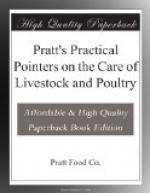When the boar arrives at the farm he should be dipped in a solution of Pratts Dip and Disinfectant, as a matter of ordinary precaution against the introduction of vermin. As an additional precaution, a quarantine pen should be ready for him, especially if epizootics are prevalent. His feed before change of owners should be known, and either adhered to or changed gradually to suit the new conditions. If he has come from a long distance it will be well to feed lightly until he is well acclimated.
[Illustration: TAMWORTH PIG]
Breeders generally advocate the practice of keeping a boar to himself during the entire year—out of sight and hearing of the sows. However, a boar is often allowed to run with the sows after they are safe in pig; but during the breeding season it is by far the best policy to keep him by himself, admitting a sow to his yard for mating, and allowing but one service. The litters will generally be larger and the pigs stronger.
The boar should not serve more than two sows daily, preferably one in the morning and one in the afternoon, and can serve 50 to 60 in a season without difficulty.
In order to keep the boar in vigorous physical condition, he should be given Pratts Hog Tonic regularly. The beneficial results will be seen in the way of larger litters and stronger pigs.
The greatest drawback to the hog industry which breeders in this country have to contend against is found in the losses which may be experienced through the infestation of the animals, especially young pigs, by parasites, through outbreaks of hog cholera or swine plague, or through the contraction of tuberculosis.
[Illustration: CHESTER WHITE BOAR]
In dealing with the diseases of hogs, preventive measures must be most relied upon. The animals must be given dry and well-ventilated quarters, which must be kept clean. Contrary to common belief, hogs have some habits which raise them above other domestic animals from the standpoint of cleanliness. For example, unless compelled to do so, a hog will not sleep in its own filth. If part of the floor of the pen is raised and kept well bedded with straw, while the rest is not, all excrement will be left on the unbedded portion of the floor, and the bed itself will be always clean.
In addition to cleanliness, close attention should be given to the feed which is supplied, that nothing may be fed which will convey the germs of disease, especially tuberculosis, to the herd. If the hogs are fed milk in any form obtained from cows kept upon the same farm, the cows should be subjected to the tuberculin test, as by this means all tuberculous milk may be kept from the hogs. If they run with the cattle of the farm a tuberculin test of all the cattle is none the less desirable. Animals dead from any disease should not be fed to the hogs until the meat has been made safe by cooking. Skim milk or refuse from a public creamery should not be fed to hogs until it has been thoroughly sterilized.




